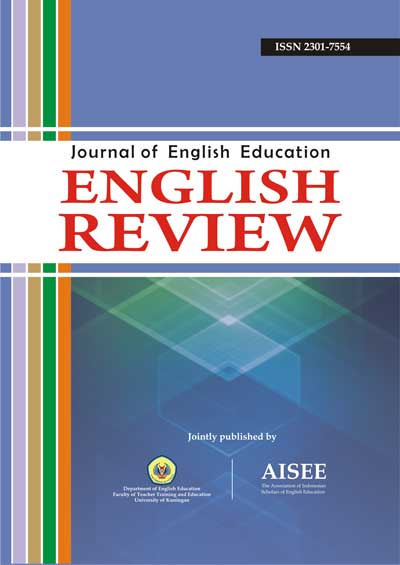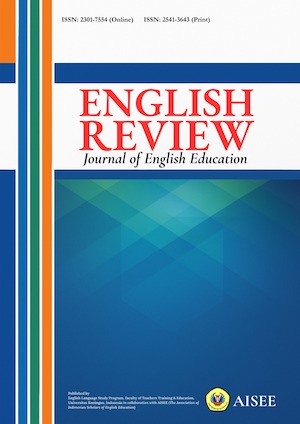PATTERNS OF RESPONSES TO COMPLIMENTS ON PHYSICAL APPEARANCE IN SUNDANESE WOMEN
Abstract
Abstract: Complimenting as a speech event has been one of the major areas on which linguists have focused their attention and drawn insights into the phenomenon of linguistic politeness in the last two decades (Zanrong 2004). Some previous research – among others are by Davis (2008); Heidari (2009); Matsuoka (2009) – revealed that gender give rise variations of strategies on compliment responses (CR). This paper examines Sundanese women responses to compliments on appearance addressed by the same and different gender. The research applied Naturalized Role Play method in collecting the data by observing the way of 68 women giving response to the compliment addressed on their physical appearance. The respondents were native Sundanese women living around Bandung. The study found that most women respond differently to compliments addressed to them by women and by men. This study also reveals that most of them considered the compliments – particularly when addressed by men – as a way of either maintaining social hospitalities or joking, and thus, the speech acts of compliments appear more to be a way of consolidating solidarity among them.
Keywords: politeness, compliments, patterns of response
References
Al Falasi, H. (2007). Just say “thank youâ€: a study of compliment responses. The Linguistics Journal, 2(1), 28-42.
Cedar, P. (2006). Thai and American responses to compliments in English. The Linguistics Journal, 1(2) 2-28.
Davis, B. (2008) “Ah… Excuse me, I like your shirtâ€: an examination of compliment responses across gender by Australians. Griffith Working Papers in Pragmatics and Intercultural Communication, 1(2), 76-87.
Han, C. Y. A Comparative Study of Compliment Responses: Korean Females in Korean Interactions and in English Interactions. Working Papers in Educational Linguistics (WPEL), 8(2).
Heidari, M. A.,M. Rezazadeh, and A. E. Rasekh. (2009). Contrastive study of compliment responses among male and female Iranian teenage EFL learners. The International Journal of Language Society and Culture, 3(29), 18-31.
Ishihara, N. (2006). Formal instruction on the speech act of giving and responding to compliments. Retrieved from: http://exchanges.state.gov/ media/oelp/teaching-pragmatics/giving.pdf
Matsuoka, R. (2009). Gender effect on compliment exchange. Retrieved from:http://klibredb.lib.kanagawau.ac.jp/dspace/bitstream/10487/3801/1/ kana-12-14-0007.pdf.
Smith, J. B. (2009). The acquisition of pragmatic competence: Compliment response strategies in learners of Spanish. Unpublished PhD Dissertation, Lousiana State University. Retrieved from: http://etd.lsu.edu/docs/available/etd-11052009-094915/unrestricted/ SmithDiss.pdf.
Tran, G. Q. (2008). Pragmatic and discourse transfer of combination of compliment response strategies in second language learning and usage. Asian EFL Journal, 10(2) 7-30.
Urano, K. (2000). Negative pragmatic transfer in compliment responses by Japanese learners of English. Shinshu University Research and Communication Language Education (SURCLE), 2, 27-38.
Zhanrong, L. (2004). The speech event of complimenting in Chinese. Retrieved from: http://media.open.edu.cn/media_file/englishcatchup/ compliment.htm
All articles published in English Review: Journal of English Education (ERJEE) are licensed under the Creative Commons Attribution 4.0 International License (CC BY 4.0).
Copyright Ownership
Authors retain the copyright of their articles and grant ERJEE the right of first publication. The journal is granted a non-exclusive license to publish, reproduce, and distribute the article in any format, medium, or platform, provided that proper credit is given to the original authors.
License Terms – CC BY 4.0
Under the Creative Commons Attribution 4.0 International License, others are free to:
- Share — copy and redistribute the material in any medium or format
- Adapt — remix, transform, and build upon the material for any purpose, even commercially
As long as they:
- Provide appropriate credit to the original author(s) and source
- Provide a link to the license (https://creativecommons.org/licenses/by/4.0/)
- Indicate if any changes were made
There are no restrictions on the reuse, reproduction, or adaptation of published articles as long as attribution is properly given.
Author Warranties
By submitting a manuscript to ERJEE, authors confirm that:
- The work is original and does not infringe any existing copyright.
- The manuscript has not been previously published and is not under consideration elsewhere.
- All sources and references are appropriately acknowledged.
- Necessary permissions have been obtained for any copyrighted materials used.










